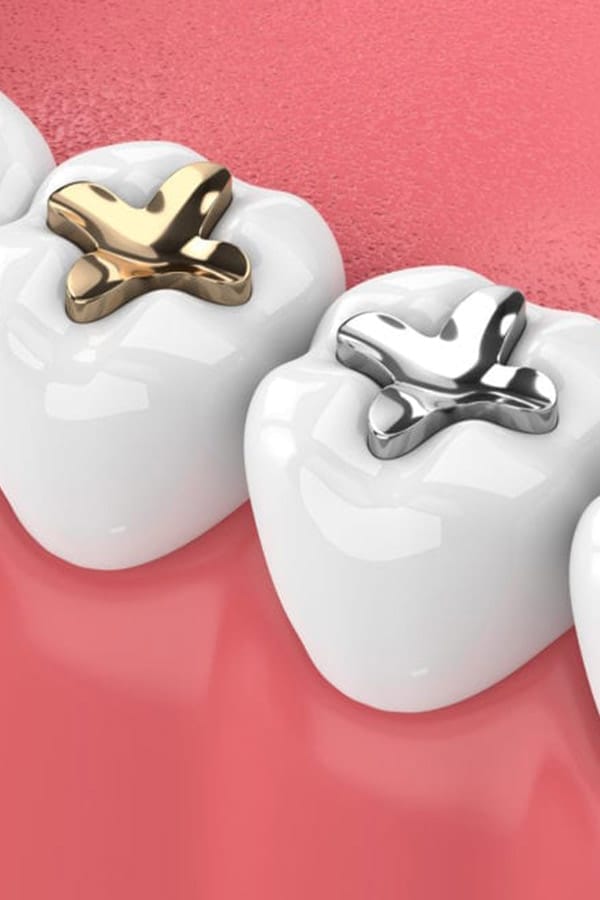

TOOTH FILLINGS
Tooth Filling, dental filling, or dental restoration is a treatment utilized for reestablishing a harmed tooth back to its typical condition. Tooth filling can be done to protect the affected tooth from further decaying.
If you experience pain while brushing and feel deep pain while eating hot or cold food items then it’s time for you to consult a dentist for further check-ups. The decayed tooth will affect the neighboring tooth even if not treated properly. The simplest form of restoring the decayed tooth is tooth fillings. The treatment for tooth decay depends upon the intensity of the cavity.
Firstly the dentist will numb the area around the tooth. An air abrasion instrument will be used for removing the decayed area. Then the dentist would check or test whether the decay has been removed or not. After removing the decay, the dentist would prepare the space for the filling by cleaning the cavity.
If your tooth is sensitive then there is a chance for pain. A special material is used to protect the nerves even if the decay is near to the root. After this process, it is advised to wash your mouth with plain water. Then the tooth fillings are applied to the cavity.
Temporary Tooth Filling
Temporary Fillings help to restore teeth dented by decay back to their standard function, and will truly avert further decay. Your dentist will ponder on several factors when selecting which type of filling material is perfect for you. These factors include the extent of the repair, where in your mouth the filling should be used, and the cost.
There are numerous reasons why a dentist may place a momentary dental filling.
Maybe you’ve just got a root canal, or it could be you’re expecting a gold filling or crown to be made for a problematic tooth. Whatsoever the reason, when you have such a dental filling, you are probably wondering what you can and can’t do until your tooth is to be permanently fixed.
Given that the tooth filling is temporary, it appears to be pretty obvious there’s need to come more easily as compared to a regular filling. How do you make sure it stays put until the next time you visit the dentist?


Temporary tooth fillings are widely-used under the following situations
- For fillings that need more than one appointment – for instance, before placements of gold fillings as well as for specific filling procedures (called indirect fillings) intended to use composite materials
- Following a root canal preparation
- To allow a tooth’s nerve to “settle down” should the pulp become peeved
- If emergency dental treatment should be used (for example to address a toothache).
Temporary fillings are simply just that; it isn’t meant to last. They usually fall out totally, fracture, or degrade within 30 days.
Be sure to get hold of your dentist to get your temporary filling replaced with a permanent one. If you don’t, your tooth could become infected, or you could have other complications.
Metal Fillings
Traditional metal or “silver” fillings are made of amalgam, a material that has been used for well over 150 years. The metals in these traditional dental fillings consist of liquid (elemental) mercury, powdered silver, tin, zinc, and copper.
Benefits of metal fillings
- They are very strong and durable.
- Traditional amalgam tooth fillings can last a very long time.
- They can be easier to place in some patients’ teeth. The material used in traditional metal tooth fillings can still be placed on your tooth when it is wet.
- They may not take as long to place.
Cons of metal fillings
- They aren’t repairable. If there is a problem like a crack or a hole in your amalgam filling, our dentists will need to replace the whole filling.
- They can’t match your tooth’s unique color.
- More of your tooth will need to be removed before the filling is placed. This is because a dentist who offers metal fillings will need to create a secure pocket for your metal tooth filling to ensure it stays put.


Non-metal fillings
Until recently, dental patients were often told that cosmetically superior tooth-colored restorations were not as durable as traditional metal-based restorations. This philosophy is now possible.
With the modern technologies of dental adhesion, resins, lasers, and state-of-the-art ceramics, new tooth-colored restorations are close to rivaling a natural tooth in strength, wear and function, and appearance.
Advantages Non-metal fillings
- They look better
- They preserve your teeth
- They work to prevent decay
- Healthier than silver amalgam fillings
- Can’t tell if you had any dental work done
Cement Tooth filling
Glass ionomer cement
This is a self-hardening mixture of glass and organic acid and is tooth-colored. This material is used for small filings, for cementing porcelain or metal crowns, and in temporary restorations.
Resin ionomer cement
This is a mixture of glass and resin polymer and organic acid that solidifies on exposure to blue light. This is also colored like the tooth.
Composite Tooth Fillings
Composite fillings are very popular these days as they can be manufactured to match the exact color of your other teeth. Made with various resins and fillers such as glass and quartz, composite fillings are highly durable and largely invisible.
More and more people are opting for composite fillings and with good reason. They can be colored to blend in with existing teeth seamlessly.
They are also known to bond chemically with teeth, giving them added strength and longevity. Also, composite fillings are more versatile than other options. They can be used to fill smaller, awkwardly-shaped cavities – so less preparation is required. In Lara Smile, we use this type of filling very often.
Advantages of Composite Fillings
- The distinct benefit of this type of filling is the aesthetics; the dentist blends the different shades to create a color that is nearly identical to the actual too.
- The composite bond to the remaining tooth structure helps prevent it from breaking and insulates the tooth and nerve from excessive temperature changes.
Disadvantages of Composite fillings
- There may be preoperative sensitivity.
- The composite shade may slightly change if you eat staining foods and drink staining beverages, like tea or coffee. The dentist can place plastic coating to prevent changes to the color of the composite.
- Composites also wear out sooner than silver fillings in larger cavities.
Photopolymer (light-curing) filling
Nowadays, few, where you can find any other filling materials in addition to the photopolymer or the so-called light-curing. Of course, there are the state dental clinics, which put the fillings are chemically curing, i.e., dry themselves under the influence of the temperature of the oral cavity.
But very few of them. Light cure materials, due to their content of the photopolymer. The seal hardens under the influence of special UV light.
Advantages
- Strength;
- The ability to choose the appropriate color;
- To give the necessary form;
- Have good adhesive properties;
- To restore all groups of teeth.
Ceramic Tooth Filling
A ceramic dental filling looks better than amalgam and gold because it’s the color of teeth. If applied flawlessly by a highly trained dentist, it can restore the original appearance of the damaged tooth. This is the popular choice among people who want a uniform hue for their choppers.
The cost of this dental filling is based on the price of porcelain and the cost of additional work to make the filling last. For ceramic dental fillings, the tooth must be reduced in size first to make room for the extra bulk the filling creates.
A ceramic tooth filling is made of porcelain. The advantage of it is that it’s more resistant to staining than composite resin material, although it’s more abrasive. Also, It can last you more than 15 years with proper care.
If you’re not meticulous with oral hygiene, however, a ceramic tooth filling may only last you a few years. If you always chew hard candies and other tough food items on your ceramic-filled tooth, you’re quite likely to break it – after all, porcelain is a brittle material.
Inlay and onlay fillings
We strongly recommend this type of treatment. It is similar to filling (it fills a hole in your tooth), it is made in a laboratory, cemented to the tooth with special glue adhesive.
Inlays and onlays are strong and can be an attractive alternative to amalgam fillings, large white fillings or crowns. They can be made of porcelain, gold or tooth-coloured filling material.
Onlays are more extensive than inlays, covering one or more cusps. Onlays are sometimes called partial crowns. Inlays and onlays are more durable and last much longer than traditional fillings – up to 30 years.
They can be made of tooth-colored composite resin, porcelain or gold. Inlays and onlays weaken the tooth structure, but do so to a much lower extent than traditional fillings. Treatment requires two visits: Initial visit – tooth preparation + impressions + temporary filling, Follow-up visit – fitting the inlay or onlay.
Process
- During the first visit, decay or an old filling is removed. An impression is taken to record the shape of the tooth being repaired and the teeth around it.
- The impression is sent to a dental laboratory that will make the indirect filling.
- A temporary filling (described below) is placed to protect the tooth while your restoration is being made. During the second visit, the temporary filling is removed, and the dentist will check the fit of the indirect restoration. Provided the fit is acceptable, it will be permanently cemented into place.
Advantages of inlays/onlays
- non-allergic
- stable, long-lasting, and abrasion-resistant solution
- colour and shape perfectly matches own teeth
- no color change in the long run, only with own teeth material parallelly
- even seriously damaged teeth can be saved using onlays

